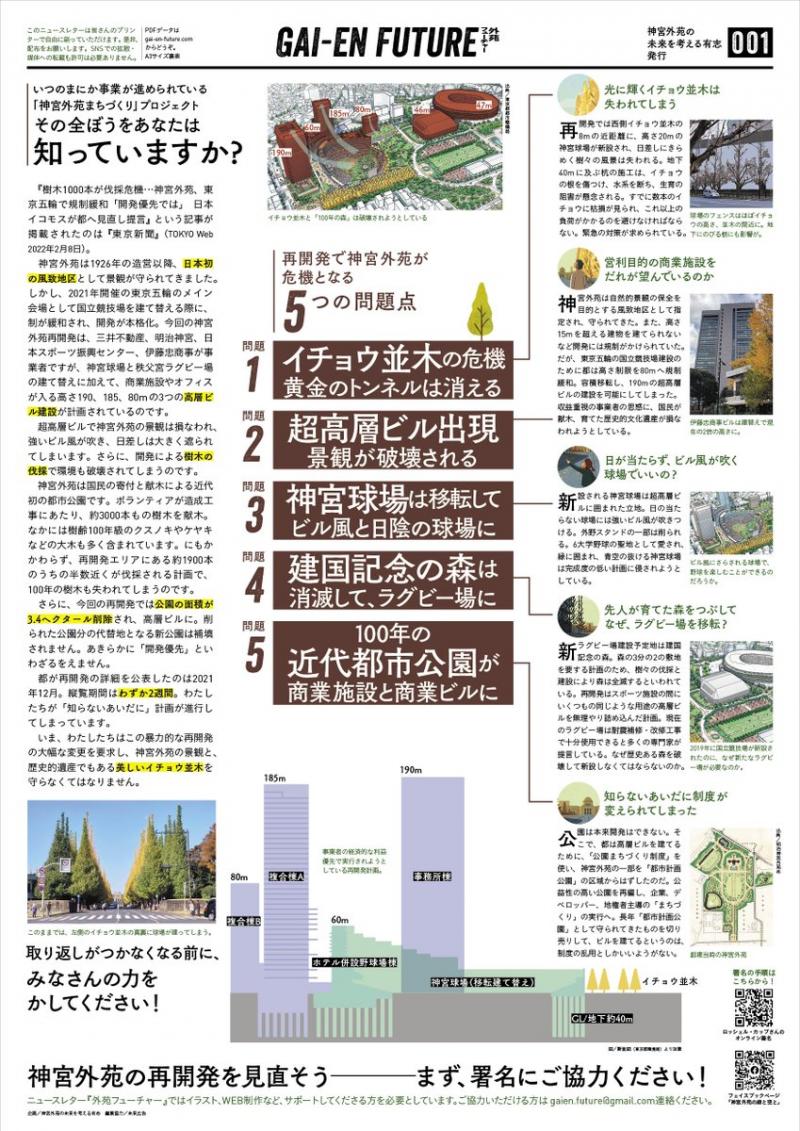Issue:
June 2023
Planned Meiji Jingu Gaien development will destroy a green and pleasant jewel in Tokyo’s crown

I like Meiji Jingu Stadium. I have been watching baseball games there since 1962, when I first came to Japan. It was a sanctuary of peace and quiet set amid evergreen trees in the middle of a cacophonous and crowded city. Built 97 years ago as part a vast forested Shinto shrine complex in tribute to the Emperor Meiji, it is rich in history. Babe Ruth and Lou Gehrig played there in 1934 as part of a Major League Baseball all-star tour.
Over the years I have watched Keio-Waseda university games there, as well as those of the Toei Flyers, the Sankei Swallows, the Sankei Atoms, the Yakult Atoms and the Yakult Swallows, showcasing some of the game’s greatest stars. I always enjoy going back because of the special ambience of the place. The atmosphere is great and so is the view of the forest.

However, a new planned project would see it torn down and, in its place, a glossy new stadium surrounded by high-rise buildings as tall as 60 floors, with a 20-story hotel attached to the infield stands. The new skyscrapers would create shadows that would envelop the field at certain times of the day and also make for wind tunnels that would affect play on the field. The outfield stands would shrink, and the Yakult Swallows popular umbrella waving oendan cheering section would lose valuable space in the outfield stands.
Another equally tragic aspect of the plan is the loss of the adjacent rugby stadium, which is slated to be demolished and rebuilt half a block away on the former site of the old ballpark, and transformed into what amounts to a domed concert hall with artificial turf. Half the present 27,000 seats would go. Several hundred trees would also be cut down to make way for the new structures.
Mitsui Fudosan, Ito-chu, Kashima Kensetsu, the Yomiuri Shimbun, NTV and the Japan Sports Council are all involved in this redevelopment with the Meiji Shrine Shinto Corporation. The Japan Sports Council is another participant. Also involved are powerful figures in the ruling Liberal Democratic Party, including former Prime Minister Yoshiro Mori, a university rugby player and one-time president of the Japan Rugby Football Union.
The plan was never vetted by the public, and environmental groups have criticized it for the wanton destruction of trees. However, all of the principals are sure to make a lot of money.
Granted, Meiji Jingu ballpark needs renovation. The seats are uncomfortable, the sight lines are bad in places, and it is lacking in barrier-free areas. But is it necessary to build another shopping mall and office complex along with a renovation, and to cut down several hundred trees in the area to do it? Don’t Mitsui Fudosan and the others have enough money already?
Koshien Stadium, which is older than Meiji Jingu ballpark, was renovated recently without harming the façade. Why can’t the powers-that-be do the same?
The trees in Meiji Jingu, in what is called the National Foundation Memorial Archive Forest, were carefully selected a century ago from a variety of species around the nation and planted to create a special oasis for the citizens of the city. Cutting them down would be and offense to the memory of those who donated them. There is also a danger that new baseball stadium’s placement will damage the roots of the trees lining the nearby the famous gingko avenue.
Project planners say the trees will be replaced but opponents note it will take them decades to grow.

Citizen’s groups have protested and circulated a petition, but despite some major media coverage – by the Asahi Shimbun, the Mainichi Shimbun, Kyodo and Bloomberg – the big TV networks have avoided the subject, perhaps because many of their advertisers are connected to the project. The Yomiuri Shimbun and NTV are, in fact, part of the rugby stadium redevelopment plan, in conjunction with Mitsui Fudosan.
What’s happening at Meiji Jingu is not a one-off event but part of a larger phenomenon – major construction companies tearing down one landmark after another, including the Ginza San-ai Building, Shiba Park, Aoyama Park and the open-air concert hall in 120-year-old Hibiya Park. This comes on the heels of the destruction of the historic Tsukiji fish market.
All of this is done to make way for more high rises, which will eliminate more green spaces and intensify Tokyo’s “heat island” effect. Indeed, Tokyo is getting hotter faster than other major cities of the world, while a survey of cities from the World Cities Culture Forum found it was fourth from bottom in terms of percentage space. It is 5C warmer in the business district than it is in the docks of Tokyo Bay.
Is it necessary to destroy every blade of grass in this city in the pursuit of profit?
Robert Whiting is a best-selling author and journalist who has written several successful books on sport and contemporary Japanese culture, including You Gotta Have Wa (1989), The Meaning of Ichiro (2004) and Tokyo Junkie (2021).

